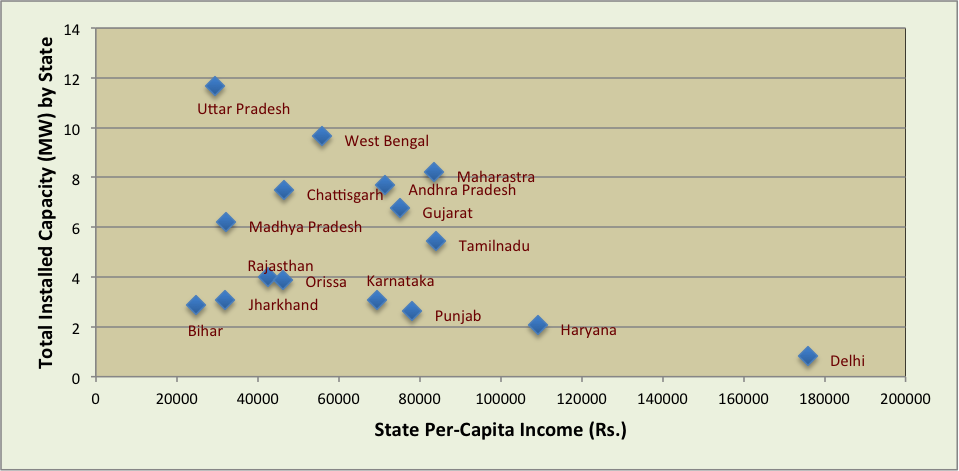by Sunita Dubey (Head of Programmes, Vasudha Foundation)
The coveted trip by the Chinese Premier Xi Ping has put a lot attention on development paths of India and China, and the lessons they can learn from each other. The two countries have signed 12 agreements in Delhi, one of which will see China investing $20 billion in India’s infrastructure over five years. Power minister Piyush Goyal said that $100 billion of investments are likely to flow into India’s renewable sector in the next four years.
While the news of Chinese investment in Indian renewable sector is a welcome move, but still both countries rely heavily on coal based power plants, and though Prime Minister Modi being a fan of solar energy still has plans for investing in coal mines and coal power plants to realize his promise of providing 24×7 energy access and electricity supply to every household in India. Even the ambitious development agenda of PM Modi is heavily reliant on the power supply (which is mainly based on coal power plants) to the industrial sector.
Development and Environmental Protection: Modi’s dream or a reality?Â
While PM Modi has firmly stated it many times that development can go hand in hand with the environmental protection, while that might be true, but it cannot be achieved by still relying and invested in coal and coal power plants. Development at the cost of environment is coming to bite China, where polluted air and water has crossed every threshold and limit.
The true cost of coal includes its toll on social structures and the environment. The mining, processing, transportation and burning of coal, and the disposal of coal waste harm the poor and indigenous communities where they take place. Threats to these communities from coal mining include population displacement, polluted or depleted water sources and the loss of livelihoods through deforestation. Coal power plants also deplete and pollute water sources, frequently being sited in areas of water stress despite their huge appetite for water. Power plants also have more widespread health implications through their toxic particulate emissions, and contribute to climate change through the greenhouse gases they emit.
Coal: A Domestic Resource?Â
While both countries take pride in coal as a “national resource”, the story has changed now with the import of coal increasing with every passing year. The acute supply shortage, coupled with the fact that domestic coal is generally of low quality, has led a number of power plants to resort to using imported coal. According to a Reserve Bank of India 2013 report, the coal imports bill adds a burden of US$18 billion every year to the country’s economy. What is more, the new generation of coal-fired Ultra Mega Power Plants (UMPPs) planned by the Indian government will only be able to use high grade coal, and so will be permanently dependent on imports.
Can Coal Fulfill Modi’s Dream of “Energy Access for all Indians?”
According to the International Energy Agency, 147 million Indians will remain without access to electricity even in 2030, if business as usual policies are followed. The pattern of household electrification rates across the country reveals a further injustice, with the coal rich states often the ones still in darkness and with the highest levels of poverty.

While the intention of Modi’s government to make energy access one of their top priority is worth appreciating, as Human Development Index (HDI) is highly co-related to the electrified households. The above graph shows that the Indian states with low electrified household have low HDI and vice versa. This graph signifies that by just electrifying a household (A desirable component would be clean and renewable energy access) can make a difference in an overall health, education and income of a family.
Hence, the government’s desire to focus on electrification and energy access is a step in the right direction, but their reliance on coal to achieve this is misguided. The graph below shows that the states with higher level of installed coal capacity have very low state per capita income. This goes against the political argument that using coal can bring social and economic prosperity.

Converting Rhetoric to Action
While the Modi government is making the right kind of noise when it comes to renewable energy, environmental protection and climate. The renaming of the environment ministry to include “climate change” is an acknowledgement of the new government’s commitment to addressing this issue. However, there action oriented approach still needs to be seen over their governing years.
On an average, every GW of additional renewable energy capacity reduces carbon dioxide (CO2) emissions by 3.3 million tonnes a year. If CO2 reductions are correlated with particulate emissions reductions, each GW of renewable energy capacity saves around 1,100 lives through reduced mortality. A further benefit of renewable energy is an increase in long-term energy security through the diversification of supply, reduction of import dependency, and mitigation of fuel price volatility. The promotion of renewable energy can also be an important tool for regional development within India, given that many of the states with the greatest renewable energy potential also lag in economic development.
Just like china, India also needs to deal with several implications of climate change on its soil, while playing a constructive role in the international climate change negotiations. A rapid surge in energy demand and the scourge of pollution in both countries, as well as the need for their leadership to play an effective role in building a consensus on the U.N. climate treaty in 2015 at the international level, places them in a position in which cooperation is indeed the best way forward.



